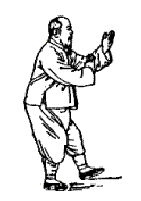

FORMS
and booklist
Forms
A form is a sequence of movements put together into a practice routine.
At Lakes T'ai Chi, everyone starts by learning a hand form, usually the 24 Step short form, or the Cheng Man-ch'ing Form. Later on, work with weapons is introduced. In a class the whole group works on the same form at the same time, so there may be mixed abilities or levels of experience working together and helping each other out. This year various groups have been working with straight Sword, Fans, and with Lung H'sin Dragon Chi Kung Form. We like to keep the spirit of T'ai Chi alive in ourselves by learning from other practitioners, and if we like something, and it works, then we will pass it on.
A 'form' is an empty vessel until it is filled by each one of us. It takes time to learn to fill that form completely so that the container (the form) and the body become one thing. Once the form is completely filled, then the process of emptying it begins, until the form once more becomes an empty vessel.
Remain awake, searching for the meaning of T'ai Chi itself.
Whether the body bends or stretches, whether it opens or closes,
Let the natural way be your way .
from the Song of the Thirteen Postures
- an anonymous T'ai Chi classic

The basic building block of T'ai Chi is a `set of forms` or usually in the west just called a form. This is a sequence of simple (yet complex!) movements which are strung together to make a routine of several minutes.
One of the historical roots of these forms is the martial training routines of the chinese general Qi Jugiang who produced a training manual - the '32 forms of fist-fighting' in the 16th century. To avoid losing too many of his soldiers in training with what is basically kung fu the sequences were performed in air with much emphasis on the exact positioning of the body for maximum effect with least use of energy.
From the inspiration of General Qi`s works, a man called Chen Wanting produced a more gentle sequence of exercises with particular focus on the way the body worked most efficiently - which is why T'ai Chi is sometimes called an `internal art`. Chen Wangting thus founded the earliest major system of T'ai Chi, the Chen style which is still a popular style.
In time T'ai Chi became even more (seemingly) gentle and the Yang style (the most popular style today) grew from the Chen style with Yang Luchan who worked for the Chen descendants around 1830. Up until then your own T'ai Chi and kung fu were generally secrets that you kept well within your family and wisely did not keep rivals fully informed as to your methods.
A set of Yang descendants such as Yang Chengfu developed the style into the 20th century and it was one of his pupils Cheng Man-ch'ing who went to America and introduced his own variant form which is possibly the most widely known today, but still has many similarities with the forms practised over 400 years ago.
Today there are many different styles and forms, and even within a particular style, there will be variations on the same form. It is easy to get hung up on forms, and focus on external differences instead of the principles we have in common and our enthusiasm for T'ai Chi. If in doubt apply a little discrimination and common sense and look for good structural alignment, relaxation, awareness of martial function, and the flowing quality of the movement.
Yang Luchan
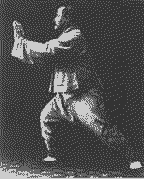
Yang Chengfu
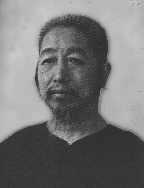
Song of Central Equilibrium
We are stable and still as a mountain.
Our Chi sinks to the Tantien,
and we are as if suspended from above.
Our spirit is concentrated within
and our outward manner perfectly composed.
Both giving and receiving energy are the work of an instant.
Wu Yu-seong
Let your spirit be like a cat catching a mouse.
Let your manner be like a hawk stooping for a rabbit.
Let your stillness be that of a mountain.
Let your movement be that of a river.
Gathering together your Chi should be like drawing a bow.
Releasing your Chi should de like loosing an arrow.
Your mind is the general, your Chi the flag, your waist the flagpole.
When Ching moves, it should be like the reeling in of silk.

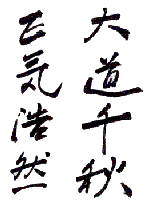
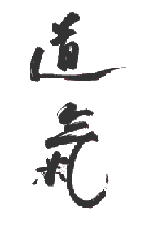
The use of weapon forms can seem suprising to newcomers in what is seen as a non-agressive sport. The following extract from 'Embrace Tiger, Return to Mountain' by Chungliang Al Huang, may shed some light.
In calligraphy the brush becomes an extension of myself and the tai ji movement. My sword practice is based on the same principle. The sword also follows the curve and structure of tai ji movement as it slashes and cuts. I practice tai ji and then extend that into a weapon, like the sword, and play with its hardness and destructiveness. The sword is very yang, so I have to work the yin into it and find balance.
The sword practice also helps me to understand the difference between fulfillment and achievement; the difference between simply doing something well, and doing it fir ocher people. or for me. Usually I resist practicing in a public place because people often gather to watch. It's flashy and impressive to them, so they make me into a performer. But alone, I enjoy it simply because it feels good to manipulate and weave the weapon around. The sword that I've been using is an imitation of an old ritual sword, the Taoist seven-starred sword. Iii the old days it was used for rituals having to do with changes in natural phenomena, like stars and planets. The seven stars on the blade represent the seven stars of the big dipper. It's a straight sword with two edges and is practiced as a solo weapon. It's quite different from the Japanese kendo sword which has a slight curve and only one edge.
The tip of the sword is called the mouth and the edges are the teeth. The movement of the sword is the wind – it flows and curves like the wind. I use these images as I practice; they help me to feel the sword as a part of me that serves me. As I move through the form I become the sword and we become the movement. The most important part of the practice is the beginning. I simply carry the sword in its sheath and walk slowly, sensing everything around me. When I feel energy gathering, I open up and draw the sword. I let it move with the energy until it settles, and then let the sword return to the sheath. The whole form is simply the drawing and returning of the sword. But when and how you draw it and return it is the meditation. There's another form practiced kneeling in which you wait alertly, yet relaxed, until the moment comes, and then you draw and rise to one of the eight directions. |
The sword is held with the empty fist and relaxed wrist, just as the brush is held in calligraphy. One exercise is to revolve the sword in continuous vertical circles, rotating at the wrist. In order to continue the circle smoothly you cannot hold the handle tightly. Your hand is so relaxed that each time the sword comes around you let it go and catch it again just before it begins to slip. By holding it lightly you make this hard, destructive weapon soft and yielding. Perhaps there are a lot of hard edges on you, too, that need to be smoothed and curved as you work. The sword practice can help you to learn how to allow that swordlike part of you to come out in the open, so you can balance the yang with the yin. This sword is you, just as the brush is you when you write calligraphy.
Other internal arts
At Lakes Tai Chi we occasionally practice Pa Kua - basic palm changes, applications, the Eight Animal Form and Pa Kua Sabre
Pa Kua Chang Pa Kua Chang is the internal martial art based around the "Book of Changes" or I Ching. It is characterised by circular movements and a practice known as "walking the circle". However, it also includes drills and linear forms, and the movements are generally performed more quickly than those of T'ai Chi Chuan. Many of the "palm changes" (ways of changing direction and striking/defending) are based around animal movements such as the snake, dragon, lion, hawk,bear, phoenix, unicorn and monkey. The turning and twisting movements of Pa Kua, spiralling and coiling, promote flexibility not only of the physical body, but also of approach. Pa Kua is known as a freestyle martial art with the practitioner able to flow and change instantly with changing demands of circumstance. Those interested in Pa Kua will find more information in Paul Cromptons book "Walking Meditation- Pakua:the Martial Art of the I Ching" (element books) |
|
Hsing-I Hsing-I is simpler in structure than either T'ai Chi or Pa Kua and appears the most obviously martial of the three soft martial arts. Again the movements are based on animals, but trying to capture the spirit of the intention in each animal. Some of the drills are founded on the five elements (or processes) of cyclical change -
Hsing I also relies on sprightly footwork. |
|